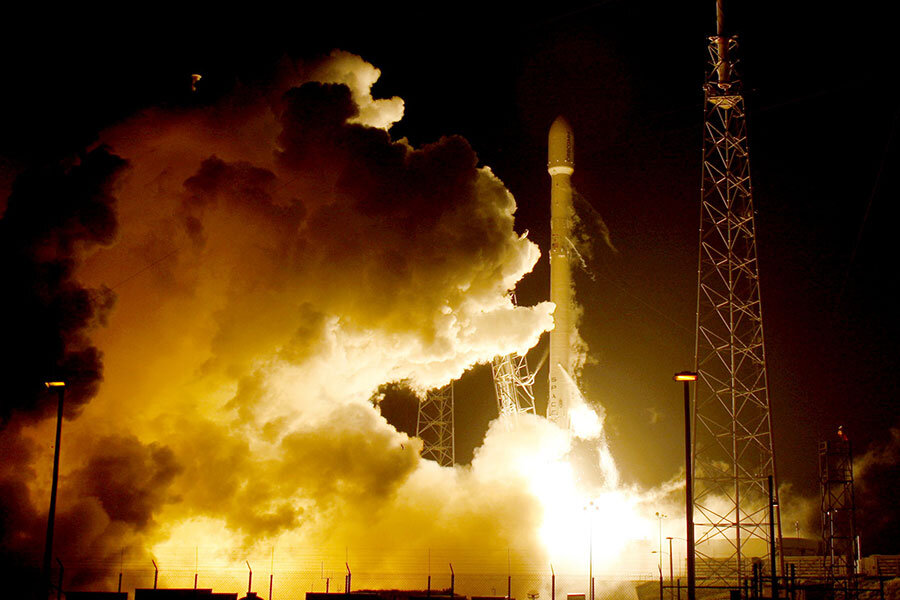Why SpaceX's rocket landing is such a big deal
Loading...
Lowering itself on a tongue of flame, the entire first stage of a SpaceX Falcon 9 rocket made aerospace history Monday night by successfully landing the same way it launched for its orbital mission: standing upright.
It's the second time in a month that one of America’s upstart rocketmakers has demonstrated a technological feat long the province of science fiction.
On Nov. 23, Blue Origin lofted its New Shepard rocket with a dummy capsule on a suborbital test flight in which the capsule returned intact and the booster landed successfully in a cloud of dust and smoke at the company's west Texas launch site.
The ability to launch, land, refurbish, and relaunch rockets with the reliability of an airliner is widely seen as crucial if humanity is to become a truly spacefaring civilization. By shifting from expendable rockets to reusable rockets, launch costs are expected to drop significantly, reducing the price tag for putting payloads and people in space.
Blue Origin took a step in returning the booster during its November test flight. Space Exploration Technologies Corporation (SpaceX) took perhaps a more historic step Monday in returning its booster after an actual mission to space that deployed 11 communication satellites.
Instead of splashing into the ocean, the booster stage of the rocket – which powered the liftoff before detaching when it was about 50 miles up – returned to a landing pad at the Cape Canaveral Air Force station in Florida. It was the first time in the history of rocketry that such a feat had been successfully accomplished during an orbital mission.
It's “a major step forward in demonstrating the technical feasibility of reusing a first stage,” says Jonathan Coopersmith, a historian at Texas A&M University whose work focuses in part on the US space program.
NASA's space shuttle program was an initial attempt at developing a fleet of reusable vehicles for human spaceflight, as well as for launching and servicing satellites. But over its 30-year history, it never delivered on its architects’ initial promises.
Initial estimates suggested that each flight would cost as little as $9 million and the cost of carrying cargo would be $118 per pound. By the end of the program, each flight cost about $1.5 billion, and cargo cost about $10,000 per pound.
Now, privately-owned aerospace companies owned by wealthy visionaries are taking up the challenge, free of Wall Street demands for quick returns on investment or of the intense scrutiny of annual federal budget cycles.
SpaceX founder and chief designer, Elon Musk, has indicated that reusable rockets could cut the cost per pound to between $10 and $500 per pound, depending on the number of launches a year.
For all the focus they receive, SpaceX and Blue Origin are not alone in striving for reusable rockets.
Last April, the United Launch Alliance unveiled Vulcan, a next-generation rocket that sheds its main engines – the most expensive part of a first stage – after they shut down. The alliance, a joint venture between Boeing Corporation and Lockheed Martin, would snag the motors in mid-air for reuse.
Two months later, Airbus unveiled Adeline, a first stage that sheds its main engines and guidance electronics. They are housed in what amounts to a winged drone that separates from the booster after the main engines shut down. The drone returns to earth, where the engines can be refurbished.
ULA hopes to launch Vulcan for the first time in 2019. Airbus aims to field Adeline by 2025.
SpaceX and Blue Origin still need to show that their booster-return systems are reliable. For SpaceX, another challenge is to try to return its newest rocket, the Falcon 9 Heavy. Three Falcon 9s, strapped together, form the new, more powerful launch vehicle. Company videos show each returning to Earth for reuse. The rocket's first launch is expected to take place as early as April 2016.
As impressive as the Blue Origin and SpaceX demonstrations have been, it still remains to be seen “how far this shifts the economic needle” in ways that increase demand for launches, Dr. Coopersmith says. “How low can you get the price, and how many customers can you get at that price?”
[Editor's note: An earlier version of this article misspelled the name of the New Shepard rocket. It was named for Alan Shepard, the second person, and first American, to travel to space.]






